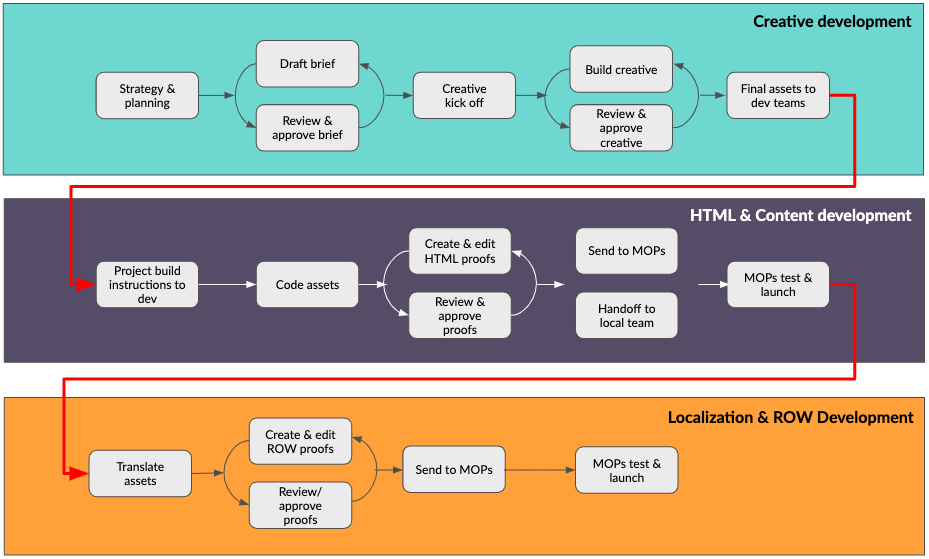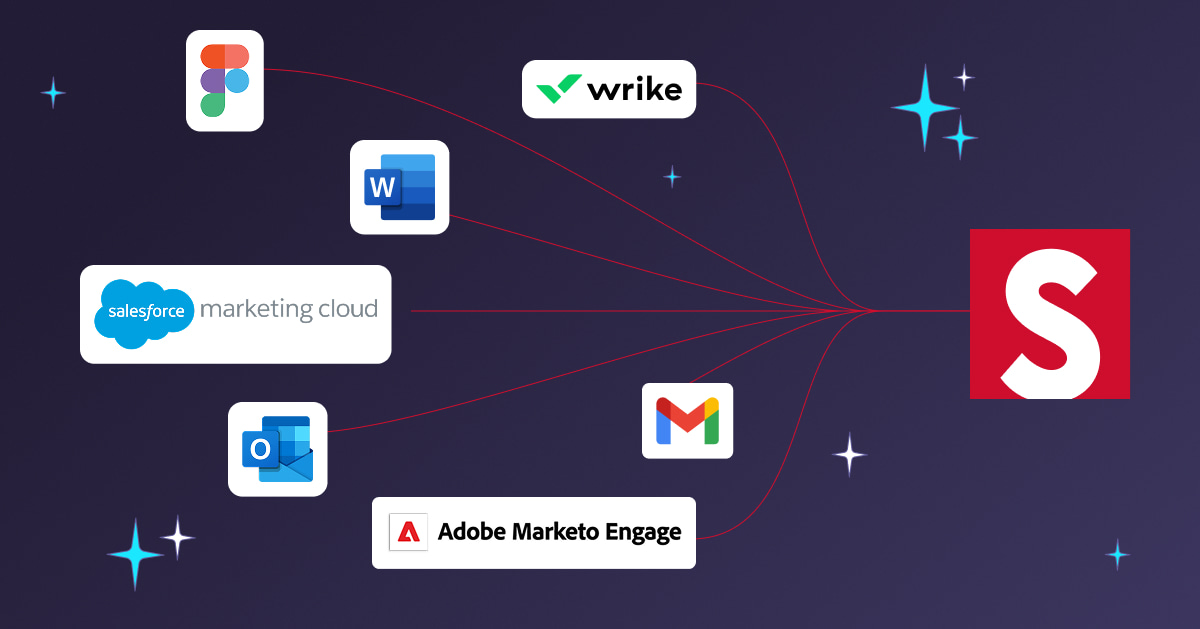We all wish that the end-to-end process of getting a marketing email out the door was as simple as build, review, and send.
If only it were that easy.
Every company’s email production process is different, but for enterprise organizations, the process is typically comprised of numerous underlying workflows with varying levels of complexity and a multitude of people/departments involved.
Sadly, enterprise orgs with dizzying email production processes aren’t an anomaly. According to Litmus, companies with 500 or more employees spend an average of 2.6 weeks to produce just one email. Taken as a whole, the process tends to look rather, well, flowchart-esque:

At stensul, we spend a lot of time thinking about enterprise email production processes and unpacking the underlying workflows. While no process is exactly the same, we frequently see some common email workflow challenges and inefficiencies that can easily be overcome with the right technology. Let’s take a look at a few of the big ones:
1. Manual Brand QA
Building an email to adhere to brand guidelines typically involves somebody combing through hefty brand guidelines and checklists, or picking design elements that look brand-appropriate based upon memory or best guess. Once the email is built, it then needs to be manually checked to ensure that everything is up to brand standards.
This doesn’t just leave the door open for inconsistent branding, it’s far more time-consuming than it needs to be.
Read More: Conquering Brand Guidelines for Email: The Complete Marketer’s Roadmap
How we do it at stensul:
Emails generated in stensul are built from modules, each of which can be pre-configured with brand guidelines already in place. For example, you could have some modules with guardrails that allow the people on your team to choose from your primary and secondary brand colors, whereas you might have other more brand-sensitive modules that only allow for primary colors to be used.
Modules can be configured with a whole host of guardrails that make it easy to create on-brand emails in minutes—font types, font sizes, logos and brand-approved images—just to name a few!
Read More: How stensul helped a global leader in cybersecurity ensure brand compliance
2. Manual Rendering Tests & Technical QA
Make no mistake about it, properly coding an email is hard work. Even a small code mistake can break the email or cause rendering issues that result in recipients receiving a poor looking email. To make things more difficult, email clients like Gmail, Outlook, and Apple Mail regularly update how they render code.
The most common rendering issues include:
- Message clipping
- Background images not supported
- Margins or padding not supported
- Custom fonts not supported
- Animated GIFs not supported
- Numbers and dates turning blue
- Text getting resized
- Broken link tracking parameters
- Rogue lines and spaces appearing between images
- Alignment issues
- Images not optimized for retina displays
- Broken merge field/personalization tags
- Improper placement of CSS for real-time email elements
Rendering tests are a way of ensuring that an email will look great for everyone viewing it. In most email production processes, the test is done by sending the code of an email through a tool like Litmus or Email on Acid. The rendering tool then shows examples of what the email will look like on different browsers and devices.
What is the problem with rendering tests?
Marketers don’t always conduct the tests in the first place, resulting in broken emails being sent. When tests are performed and issues are discovered, the person responsible for resolving them has to search through the code and determine how to fix it.
What’s more, rendering tools aren’t always accurate (it’s possible to see something render one way in a rendering tool and another way on the device itself) and are time-consuming.
The result? Unforeseen issues and unpredictable fix timelines that cause deadlines to be missed.
How we do it at stensul:
We take the human component out of rendering tests and code updates to save marketers time and enable them to get great looking emails out the door faster.
Each stensul module is run through Litmus, Email on Acid, and a physical device library to ensure that all emails built in the platform render properly across all browsers and devices. We also keep our code up to date to reflect the latest rendering rules of all major email clients, which means someone on your team no longer has to do it manually.
Stensul modules also speed up technical QA by preventing mistakes before they occur. A great example is task-based alerts that recognize when someone forgets to add a URL to something that should be hyperlinked and prompts them to add it before the email can be approved.
3. Inefficient Collaboration During Review and Revision Rounds
One of the most time-consuming aspects of email production is review and revision rounds.
Much of the inefficiency is rooted in people and communications. The best way to avoid those last minute “Oh, so and so should also take a look at this, too.” moments and endless feedback loops is by establishing clear expectations, roles, and deadlines for all review and revision rounds.
Another point of friction during the review process stems from the physical flow of feedback and revision requests. It’s all too common for team members reviewing an email to share feedback and edit requests in multiple locations (Google Docs, Word docs, spreadsheets, Slack, email, verbally). This forces the person responsible for applying the edits to gather and consolidate everything before making the changes to the actual email (in yet another location).
Not only is this an inefficient workflow, it also limits visibility into what changes have been requested or resolved. Many teams use task management tools to help streamline things and increase shared visibility, but these tools don’t fully address the issue of reviews and edits happening in different places.
How we do it at stensul:
Updates, comments, and edits are natively done in stensul, which eliminates the need to export drafts or switch between docs/systems to gather and resolve feedback. And to improve visibility, comments and edits are threaded to help teams stay on the same page.
4. Maintaining Legal Compliance
Marketers today are responsible for following global regulations surrounding email, where failure to comply with international laws such as CASL, CAN-SPAM, and GDPR could potentially lead to expensive fines. Finance, pharmaceutical, and healthcare industries, in particular, must follow industry-specific requirements to avoid any serious trouble.
How we do it at stensul:
Stensul simplifies the complex endeavor of adhering to email laws and regulations by taking the human component out of compliance.
Based on the policies and regulations that are applicable to your business, we configure your emails with guardrails that can automatically enforce a variety of compliance standards, such as:
- Accurately representing who the email sender is
- Requiring the sender’s physical mailing address
- Requiring a working opt-out link
- Accessibility rules (WCAG and ADA compliance)
- Industry-specific laws (finance, pharmaceutical, and healthcare)
Ready to Transform Your Email Workflows?
Stop building your emails at sloth speed! if you have any questions, tweet at us @stensul or request a demo today!




